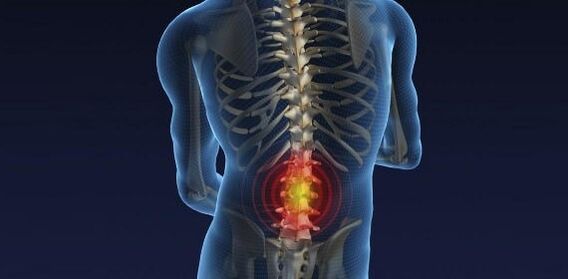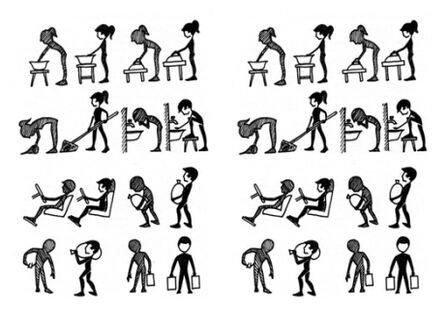
Pain in the back and limbs is one of the most common disorders.It is the second most frequent cause of medical care after respiratory diseases.About half of the people of working age during their lives endure episodes of back pain and prolonged disability.
What is osteochondrosis
Osteochondrosis is a disease in which intervertebral disc degeneration occurs.
The intervertebral disk consists of a fibrous ring (concentric layers of strong connective tissue fibers) and a jacket nucleus in the center. The share of the discs accounts for about a quarter of the length of the spine, they play the role of shock absorbers - with a vertical position, turns, inclinations and extension of the spine, the nucleus and the fibrous river of the disc, it takes the stop of axial loads, it occupies itStarting position.A significant load falls on the disks of the lumbar and cervical spine, since these departments have the greatest mobility.This explains the fact of the greatest severity of degenerative changes in the cervical and lumbar spine.
One of the causes of disks degeneration is their insufficient nutrition, which, in turn, is a consequence of a person’s weak physical activity.
The water content and the elastic properties of the disk are also significantly reduced with age.The fibrous ring of the disk loses its elasticity, cracks appear in it, in which, at each new load, the jacket nucleus begins to be introduced more and more, moving to the edge of the disk, with the full rupture of the fiber ring, the contents of the nucleus go beyond its limits - there is a hernia of the jacket nucleus.More often, a lateral displacement of the disc occurs in the direction of the intervertebral hole through which the spinal cord spine passes.In this regard, the most frequent manifestation of a hernia is to squeeze the corresponding root and the development of a characteristic pain syndrome.Under the influence of pulses from the receptors of the affected segment, the spine muscles reflexively tenses, their asymmetric stress causes lateral curvature of the spine-scrap
Risk factors for osteochondrosis
Currently, the risk factors for the occurrence of pain manifestations of osteochondrosis include:
- hereditary weakness or congenital defects of the spine;
- spinal injuries that lead to structural changes;
- heavy and unbalanced physical activity;
- long stay in a forced pose with distortion and turn;
- Hypodynamia, inactivity, monotonous work.
Contributing factors in the occurrence of osteochondrosis and its exacerbations can be various infectious diseases, cooling, overwork, power disorders, including a lack of vitamins, obesity, environmental factors and habits, endocrine disorders, etc.
What to do if the back is sick
Pain is a warning signal and protects from harm to the effects inside the body.First, the pain occurs when moving, changing the posture and passes at rest, as the disease progresses, morning stiffness appears, which can last 30-60 minutes.The duration of the disease can be several weeks or months.
What to do if the back hurts?Be sure to consult a doctor during the first 3-5 days (to avoid chronizing the disease).Use simple tips, in addition to the doctor’s recommendation:
- Overload should be avoided.To avoid problems, try to constantly monitor the correct position of the body.Excess weight increases the load on the spine.Not all sports are the same useful.It is better to avoid game sports and jumping and choose hiking, skis and swimming - they will only benefit the spine.

- Correctly organize sleep, food and rest. For the maximum effect, choose a fairly tough mattress, and an orthopedic pillow will be the best choice.
- Organize your workplace correctly.The chair with a low seat, inclined towards the back, which should be convex at the place of the lumbar spine (or it is recommended to lay a roller), will be ideal.
- Position treatment.With a fairly high roller installed under the lower lumbar lordosis, the "tense" muscles relax, the pressure on the rear parts of the damaged discs of the lumbar spine decreases, the pain decreases.After a working day, it is advisable to spend 30-60 minutes in this position at home before bedtime.
- Therapeutic gymnastics (exercise therapy).Gymnastics forms a strong muscle corset around the spine, devote 15-25 minutes to it daily (you can for 2-3 approaches).The set of exercises should be prescribed by the treating doctor depending on the intensity of pain, at the end of the article we will give the most common complexes of therapeutic exercises depending on the period of the disease (acute phase, remission, etc.)
Motor mode recommendations in the acute period
In the acute periodIn the presence of acute pain, strict bed rest should be observed.LFK is used mainly with hygienic purpose and is of a general strengthening in nature.Exercises that cause pain should be limited in amplitude, degree of muscle tension or excluded at all.It is very important not to engage in pain and do everything very slowly, repeating each exercise 8-10 times.
When moving the lower extremities, prevent an increase in lumbar lordosis (bending the spinal column forward), which can enhance the pain syndrome.At the second stage of the acute period, with a decrease in the intensity of pain, you should carefully include isometric exercises for training the abdominal muscles and large gluteal muscles.
With a decrease in pain syndromeThe possibilities of using special and developmental exercises increase.In this period, in addition to exercises that increase the strength of the abdominal muscles and the hip muscles, exercises are important, with bending of the lumbar spine.
When choosing both special and developing exercises, it is important to ensure that they do not increase lumbar lordosis.Pain is a signal to a change in the structure of the exercise (towards relief) or to exclude it.At the end of the second period, you should gradually include exercises that increase the strength of the back muscles, they can be performed in a circular system 2-3 times.They are the most important.Take the number of repetitions of special exercises to 15-50 times.The pace of exercise can be gradually increased.
In the period of remissionExercises to increase the mobility of the spinal column are added.However, exercises aimed at solving this problem should be carried out carefully and in lightweight starting positions.Automatism should be achieved by the maintenance of a specific posture in the standing position and in walking, when the lumbar spine is bent. The reduction of the repetitions of special exercises of the second period increases to 50-100 times (it can be broken during the day).The use of the exercise therapy in the pool is recommended for the period of the period, but the gymnastics in the pool does not replace, but complements the main "dry" classes.
Of the other means of exercise therapy, it is recommended to use those that will not affect the negative ways on damaged discs: swimming, terrenur, skis, running path, bicycle ergometer, exercises with a rubber bandage.Apply such means as volleyball, tennis (large and small), road bicycle, cross -country running, fast dancing, rhythmic gymnastics should be extremely careful, becauseSudden movements and turns can provoke an exacerbation of osteochondrosis.Exercises with dumbbells are preferably performed in the position of lying (on the back, abdomen) to exclude vertical loads on the spine.
The exercises using pure hanging due to the strong tension of the stretched muscles of the body, jumping into the depths of the elevation, exercises on the rowing machine, and throwing are undesirable.In any case, during exercise therapy, it should be remembered that the constant injury and overload of the spine, the shocks along the axis of the spine prepare the appropriate background for the breakdown of the damaged disk and the exacerbation of the pain syndrome.























